
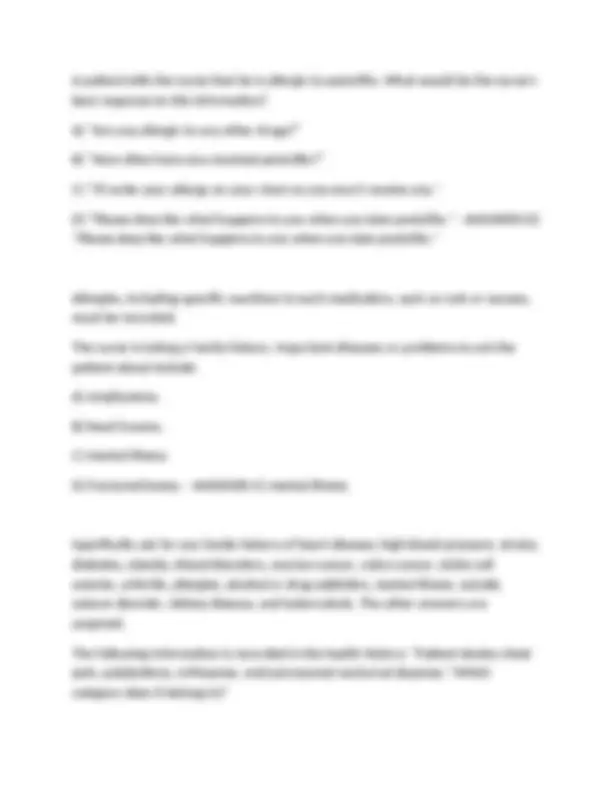
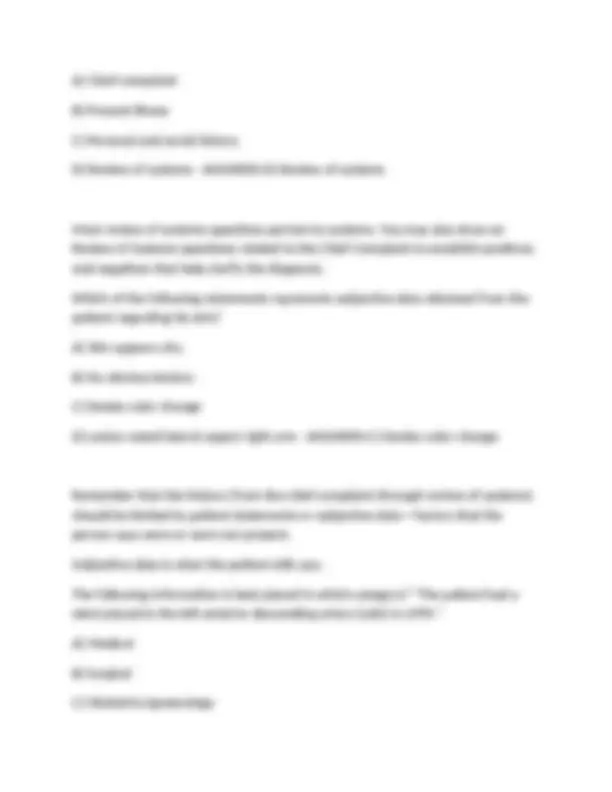
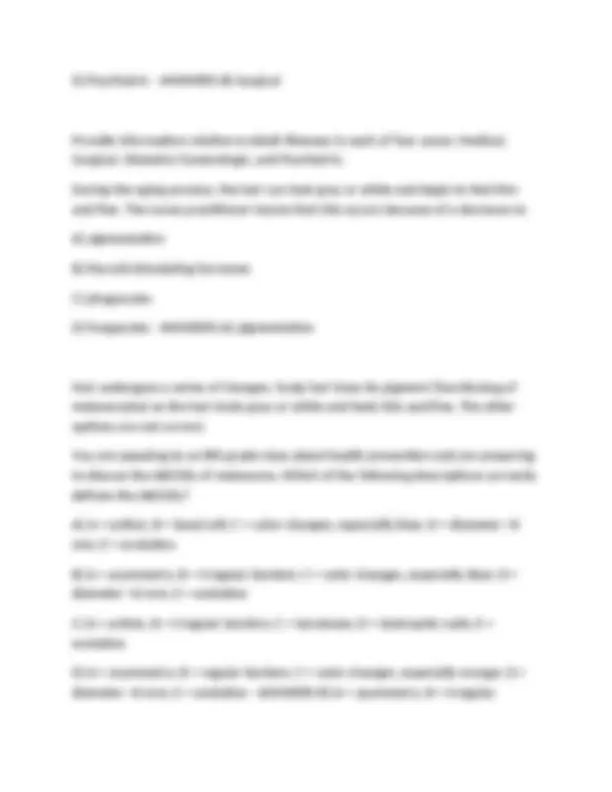

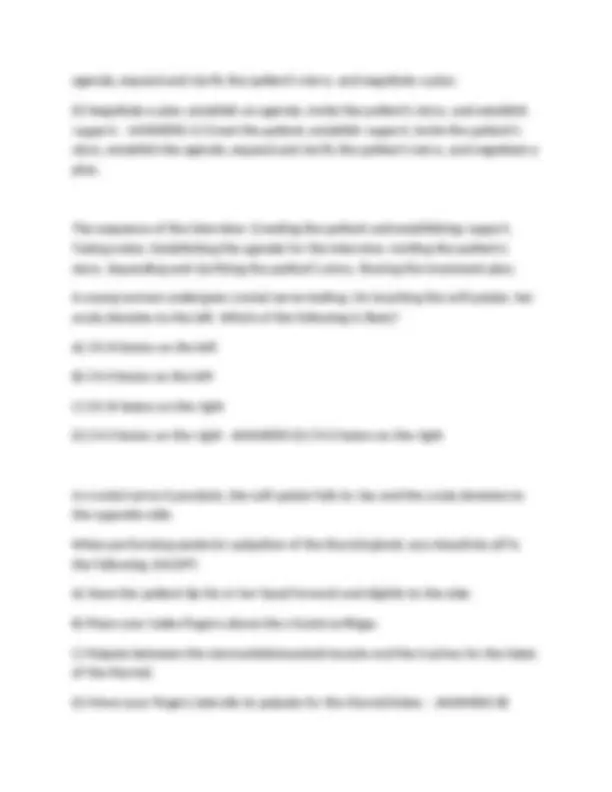
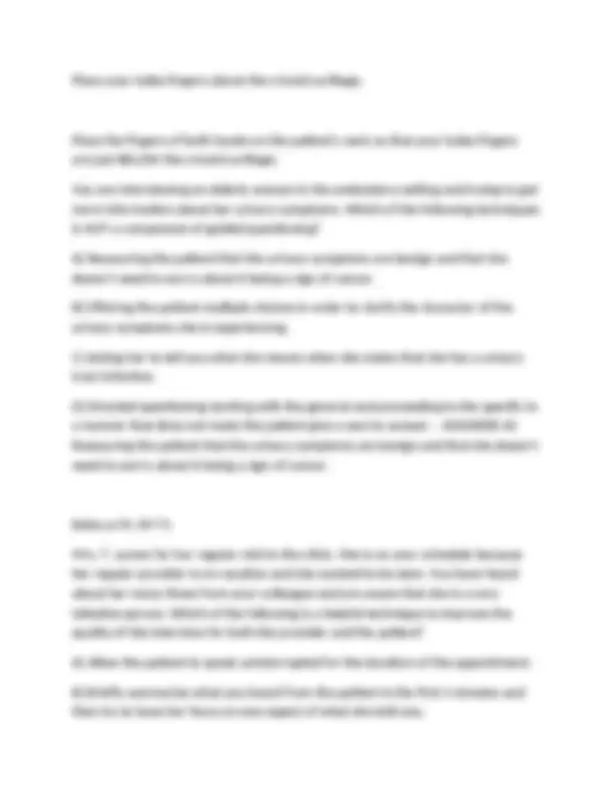
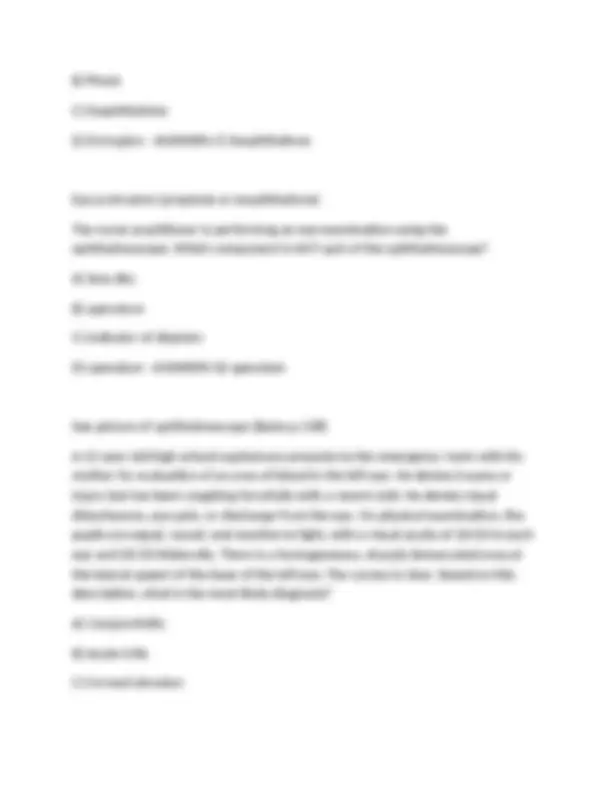
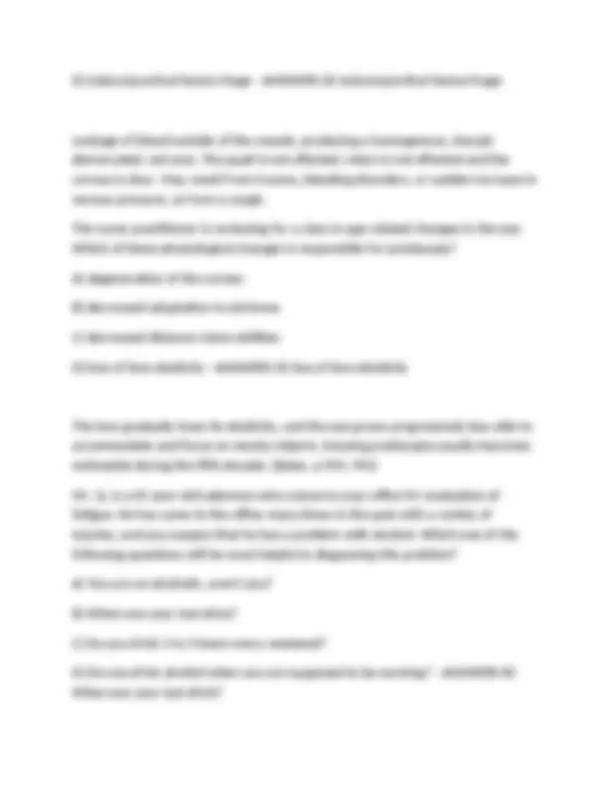
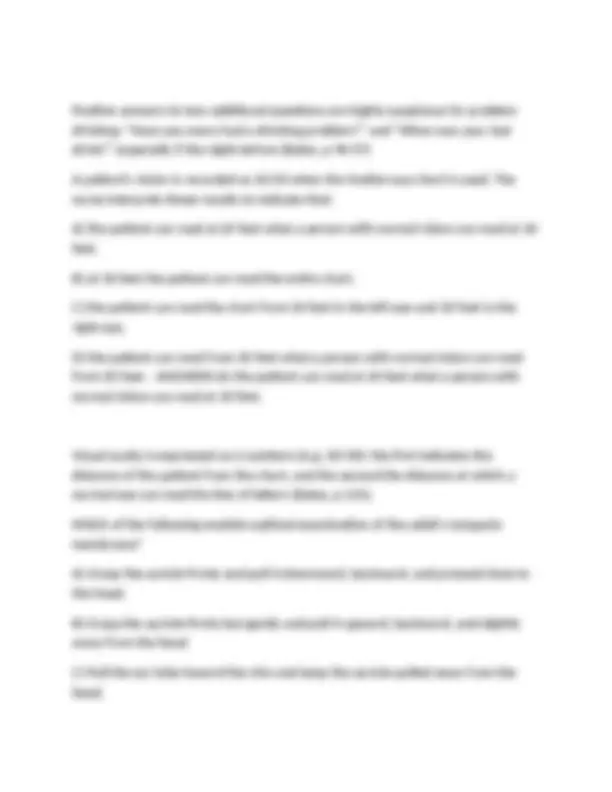
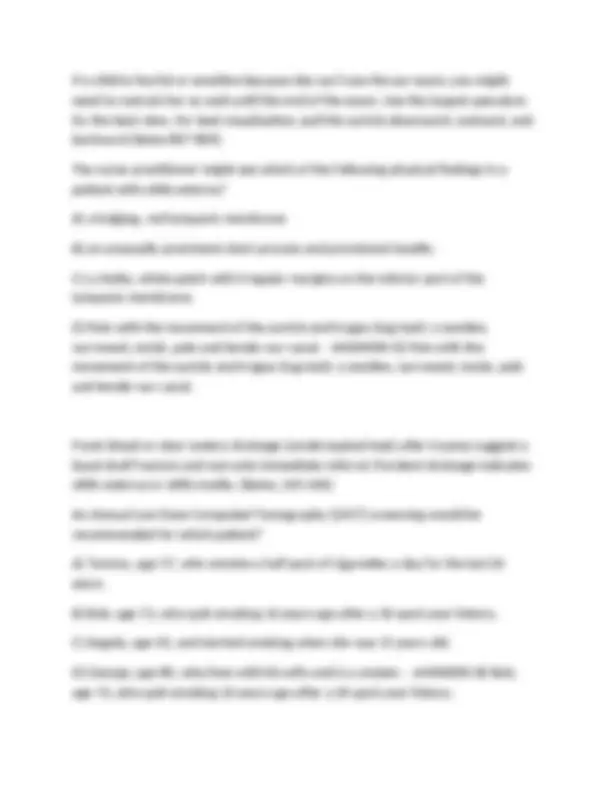
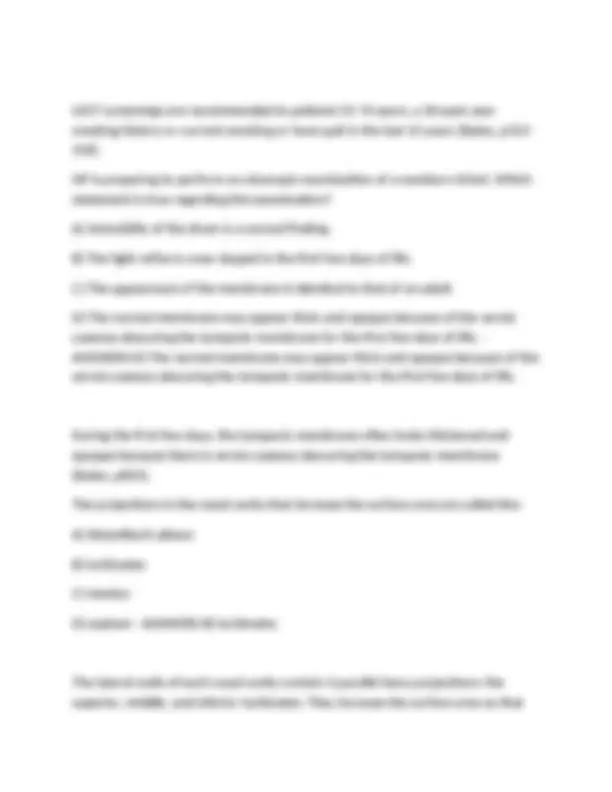
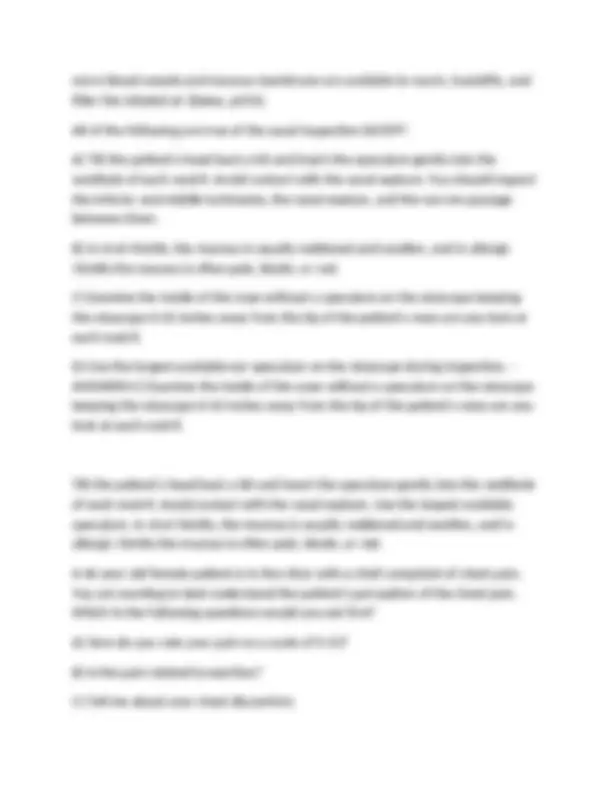
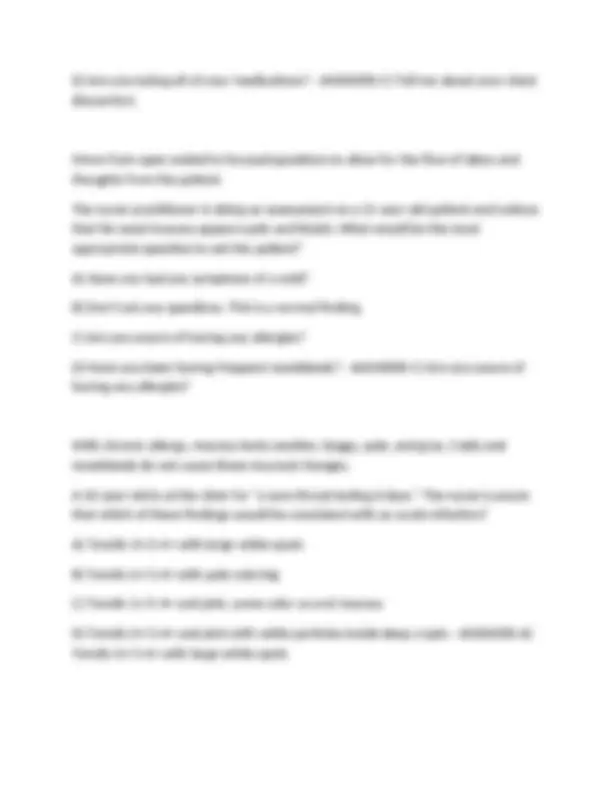

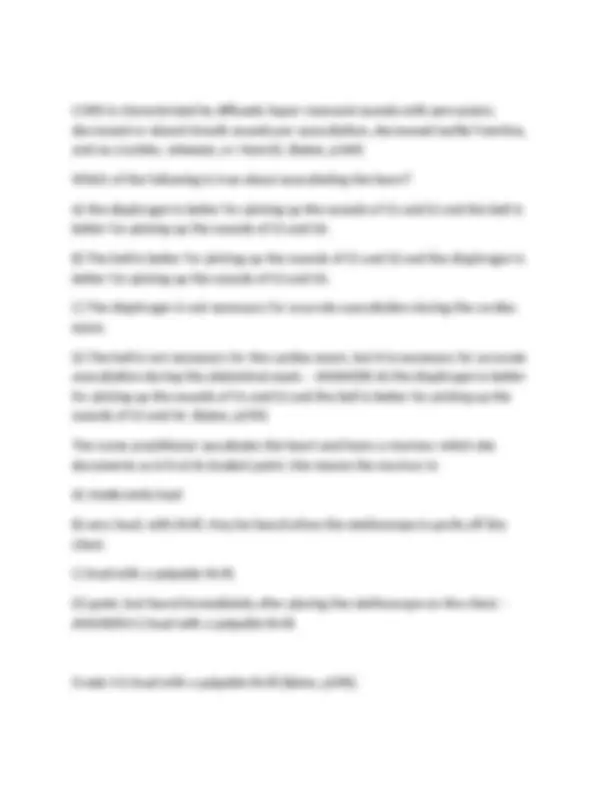
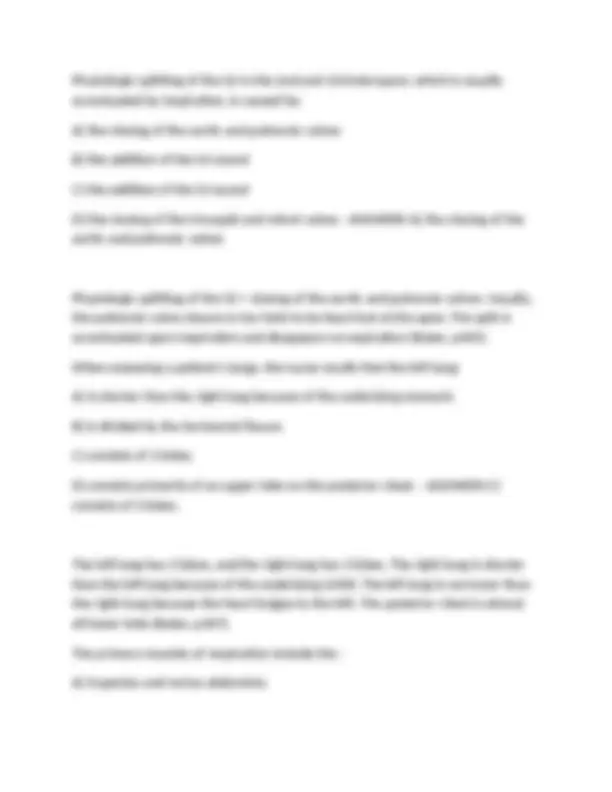
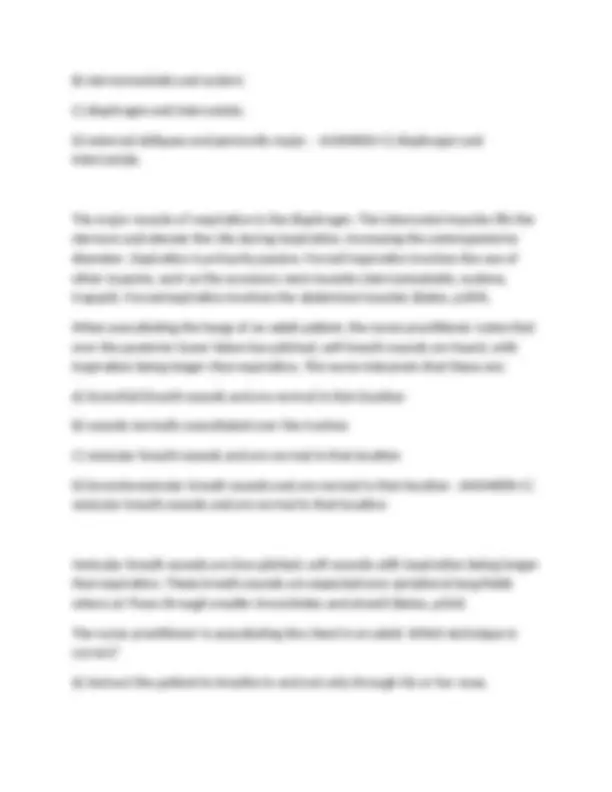
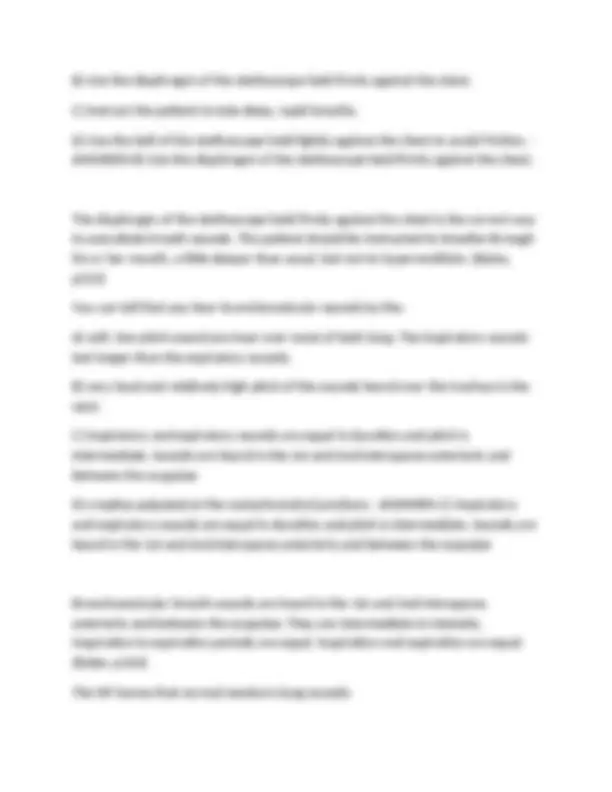
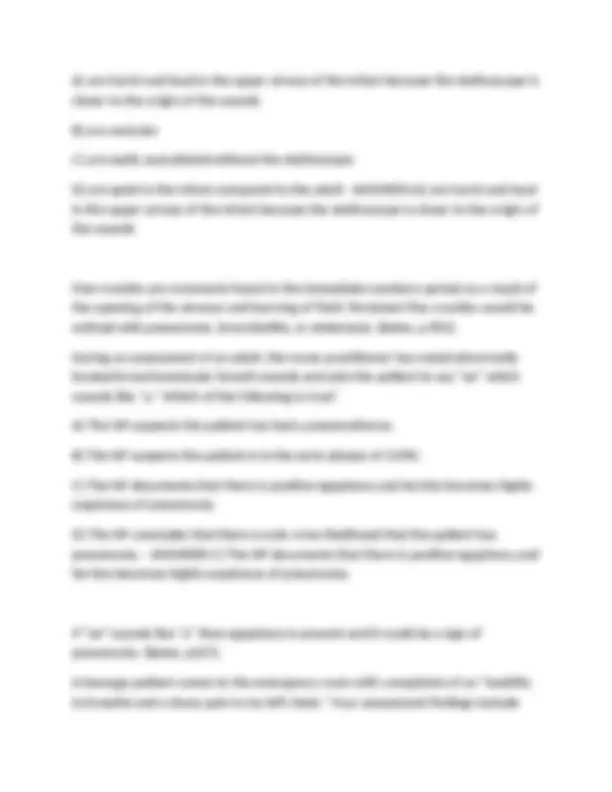
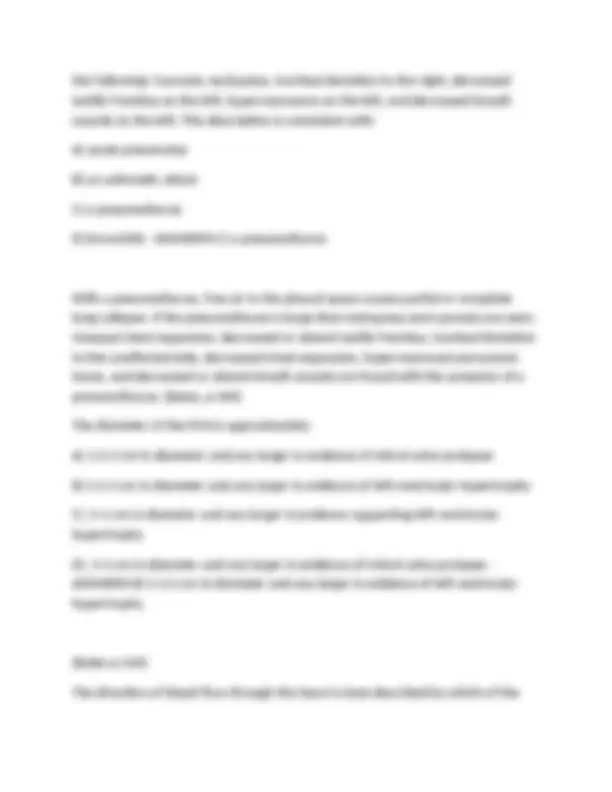
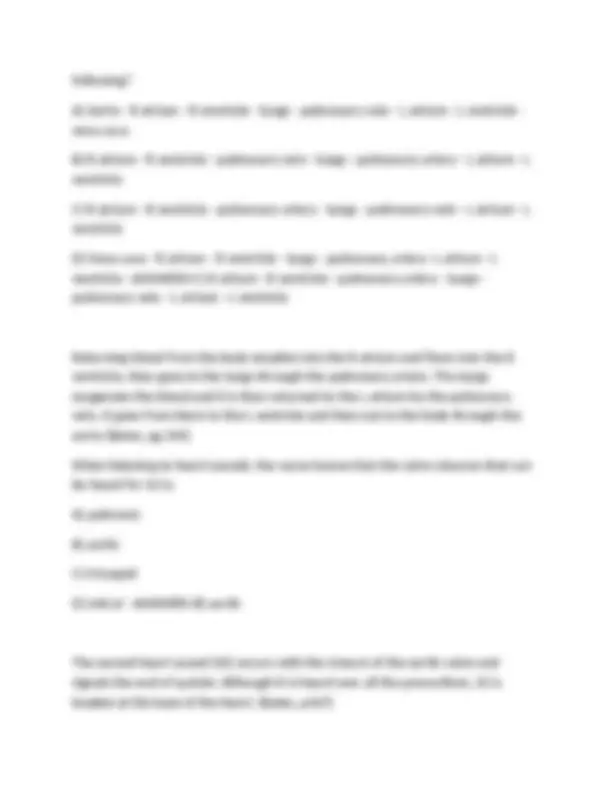
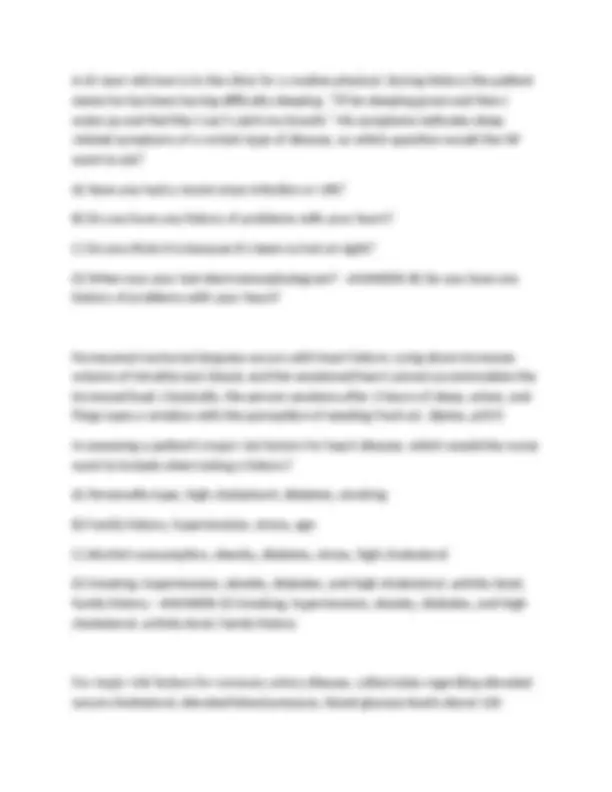
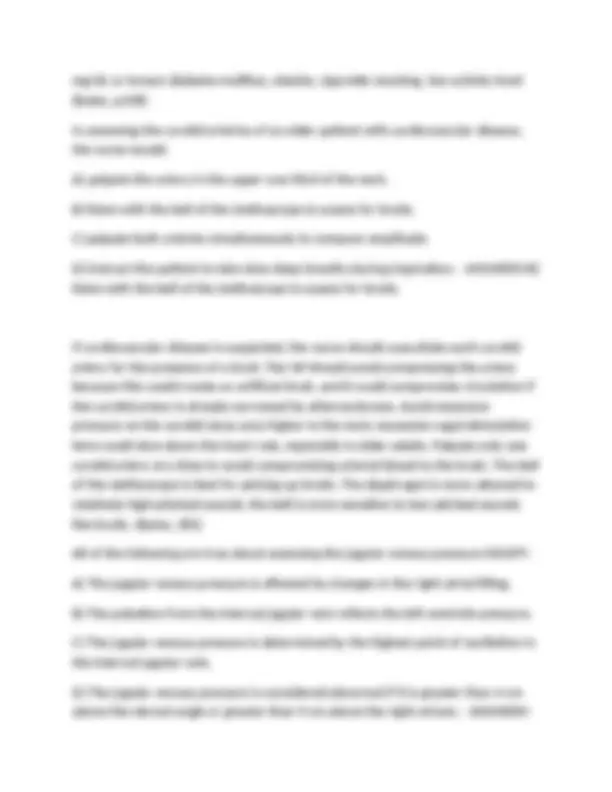
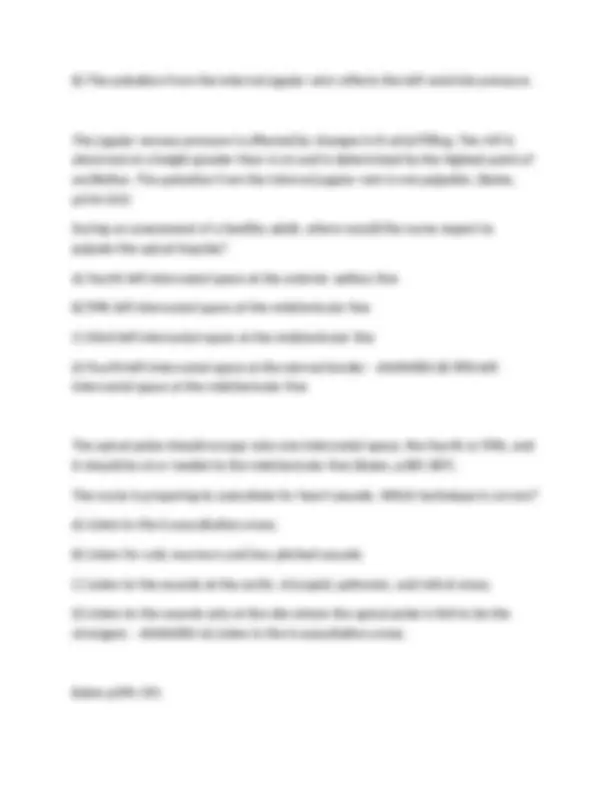
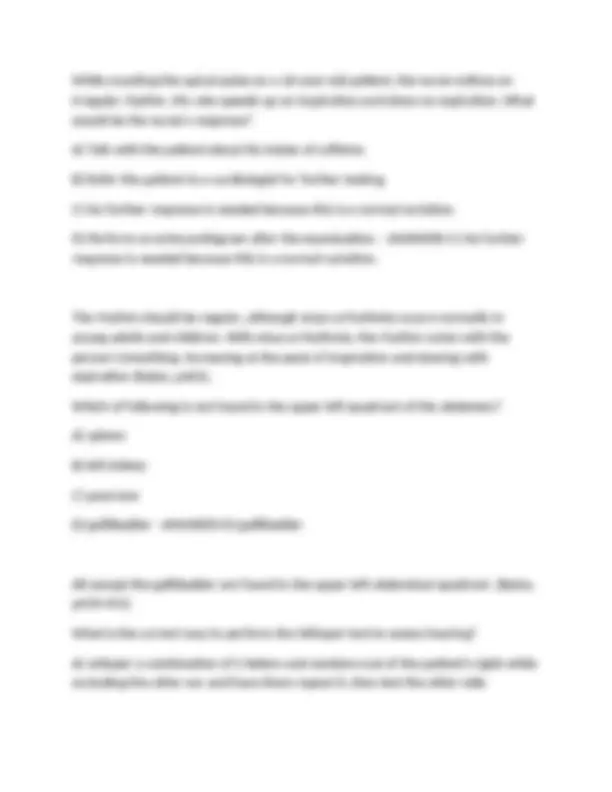
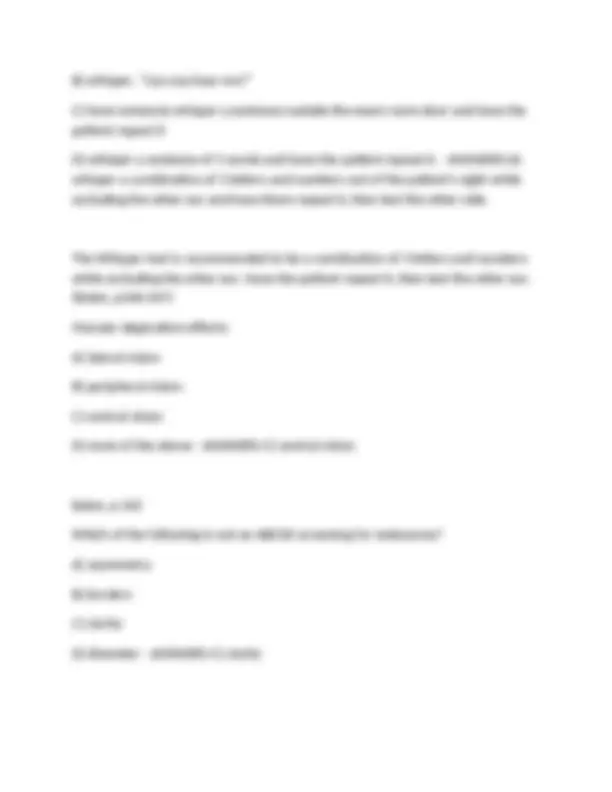
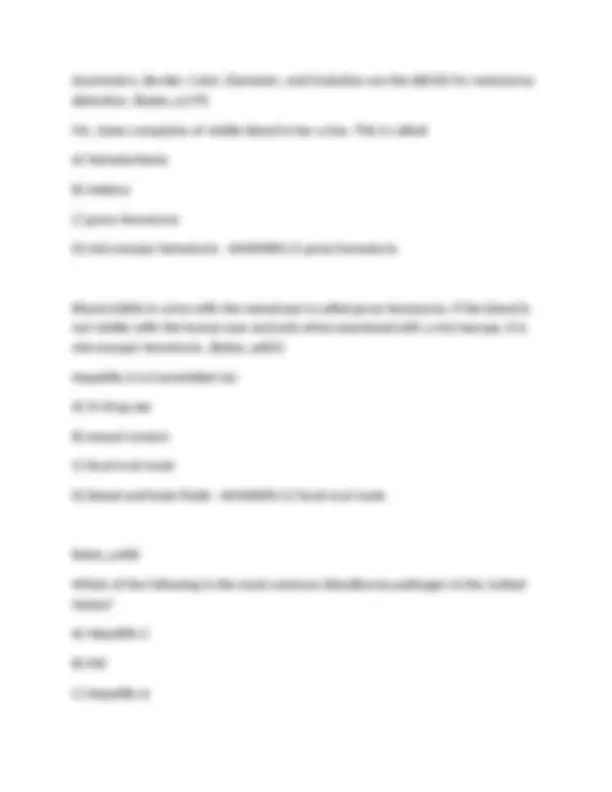
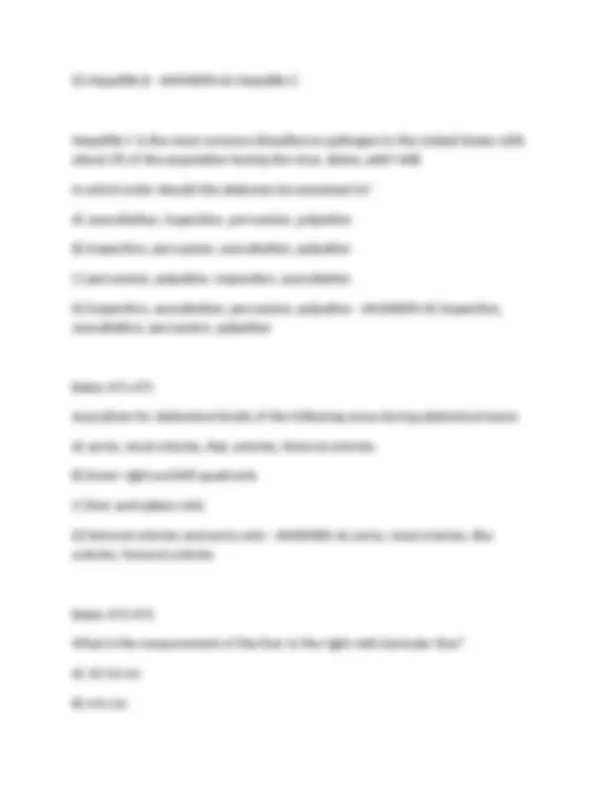
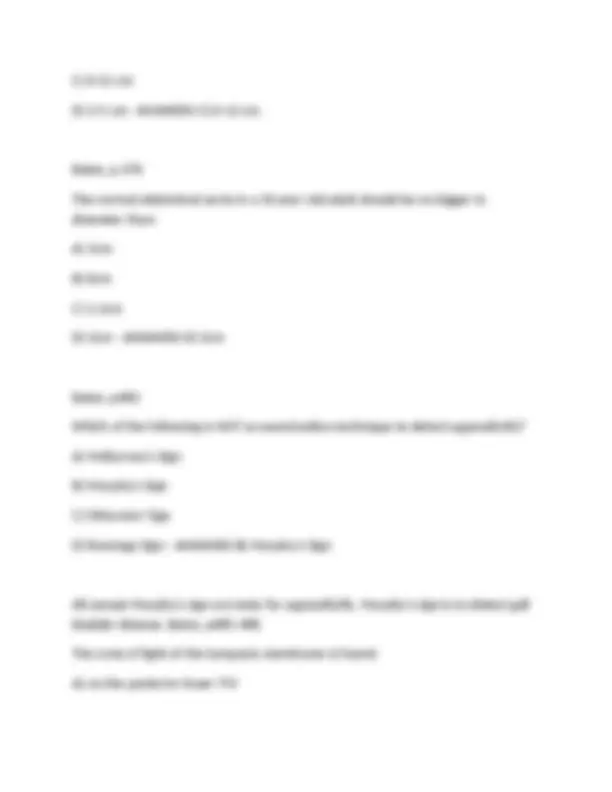
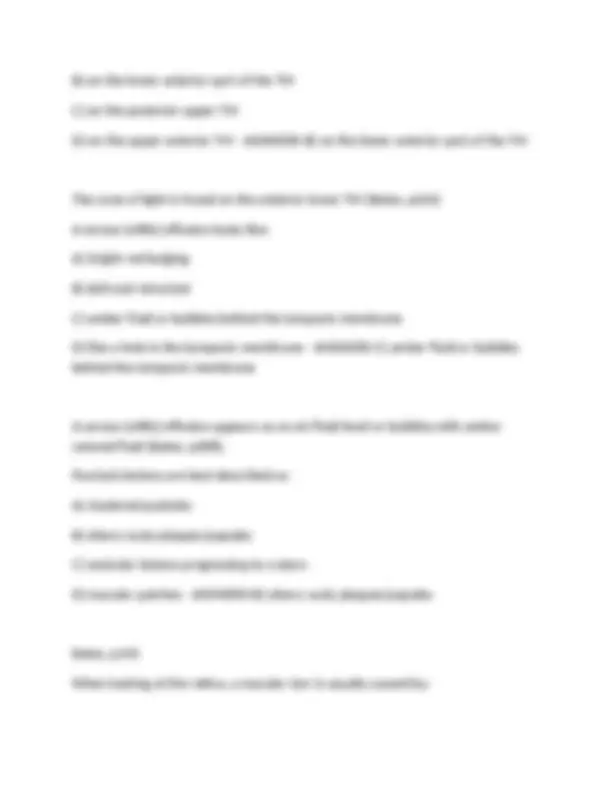
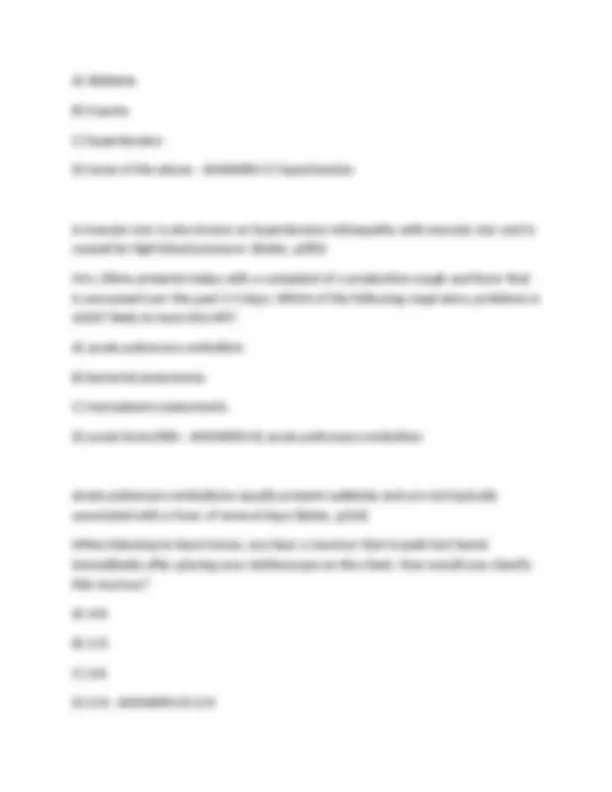
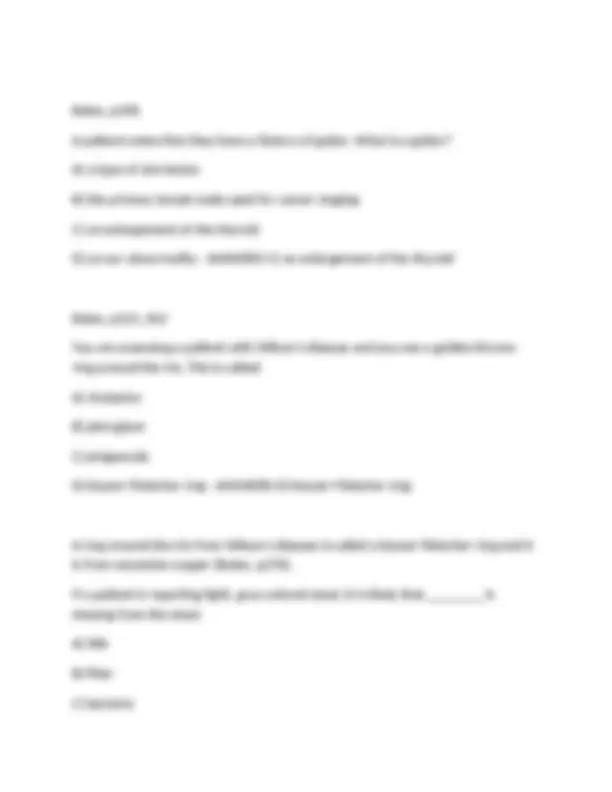
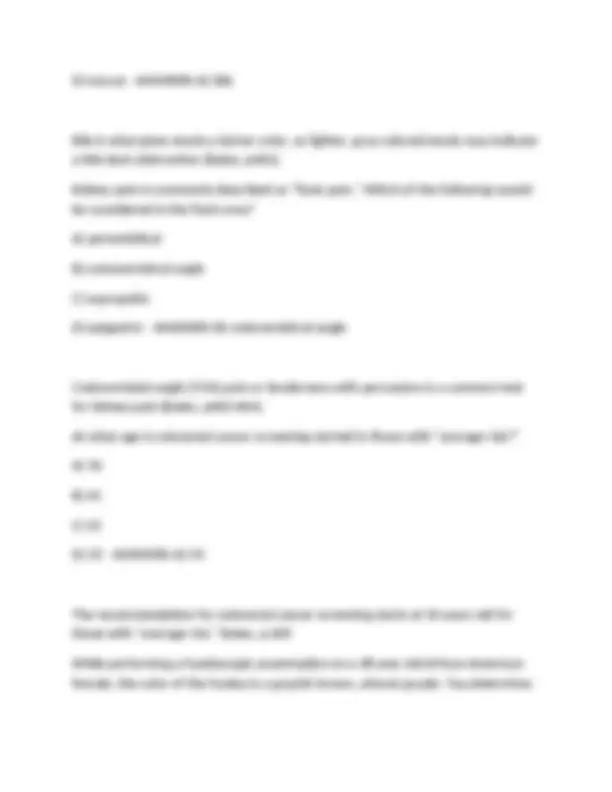
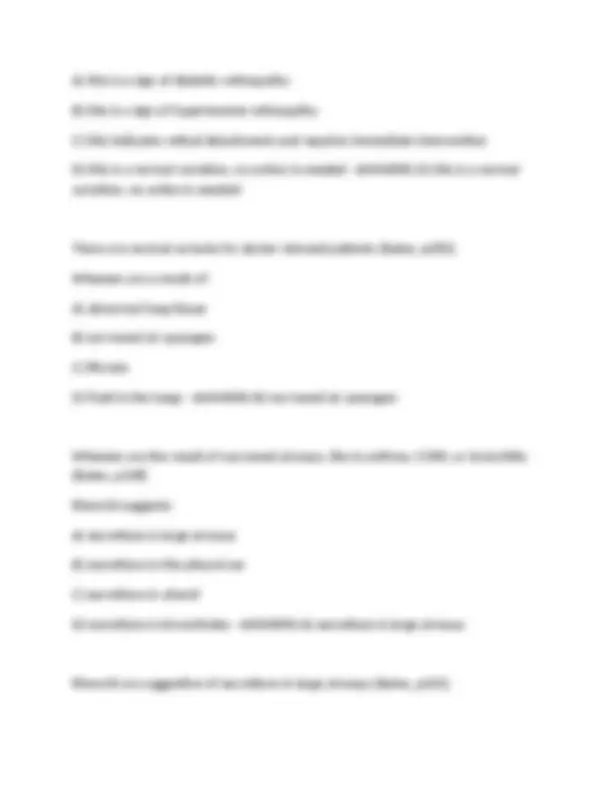
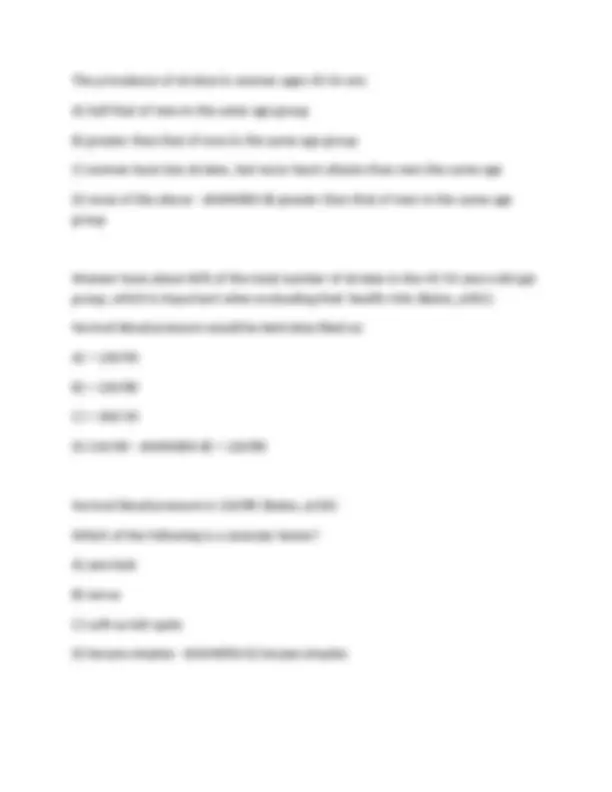
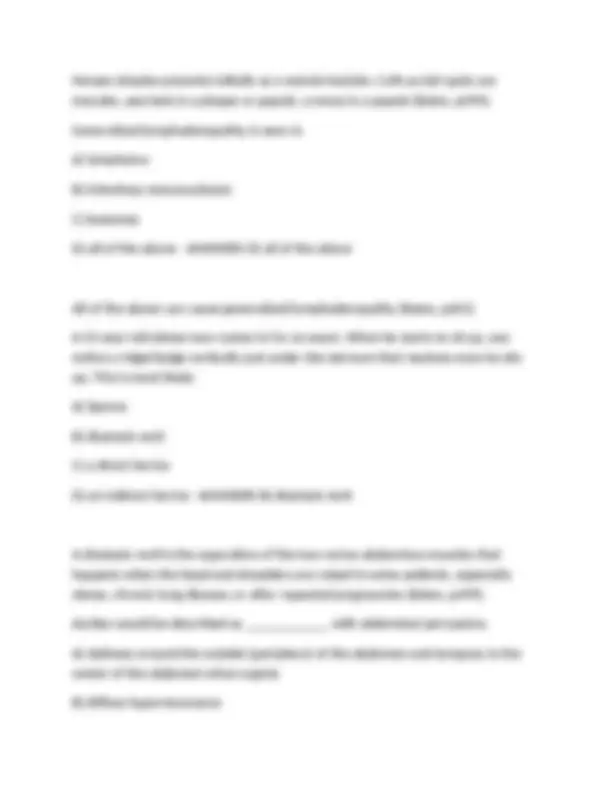
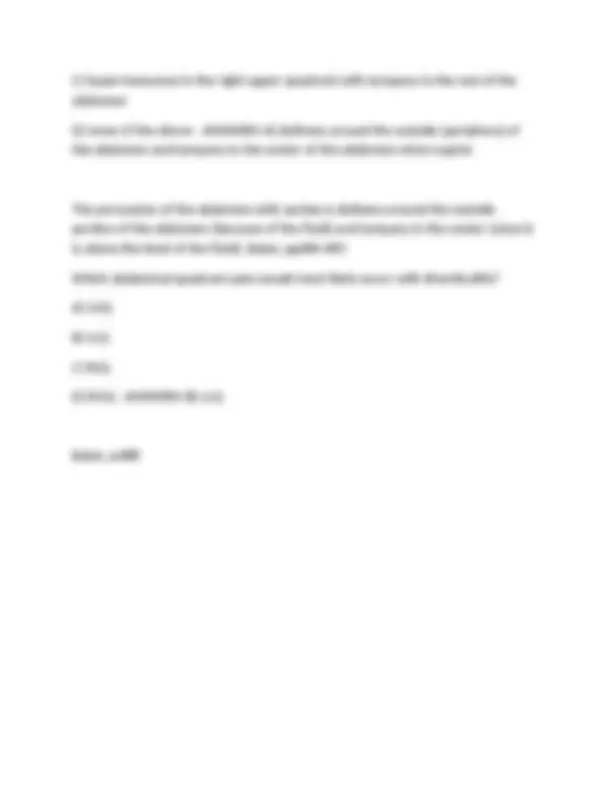


Study with the several resources on Docsity

Earn points by helping other students or get them with a premium plan


Prepare for your exams
Study with the several resources on Docsity

Earn points to download
Earn points by helping other students or get them with a premium plan
Community
Ask the community for help and clear up your study doubts
Discover the best universities in your country according to Docsity users
Free resources
Download our free guides on studying techniques, anxiety management strategies, and thesis advice from Docsity tutors
NUR 5354 Exam 2 Questions With Complete Solutions 2025 Latest Update Graded A+ Pass. NUR 5354 Exam 2 Questions With Complete Solutions 2025 Latest Update Graded A+ Pass.
Typology: Exams
1 / 45

This page cannot be seen from the preview
Don't miss anything!






































A 59 year old patients tells the nurse practitioner that he thinks he must have ulcerative colitis. He has been having "black stools" for the last 24 hours. How would the nurse practitioner best document THE FACTS for his reason for seeking care? A) JM is a 59 year old male here for having "black stools" for the past 24 hours. B) JM came into the clinic complaining of black stools for the past 24 hours. C) JM is a 59 year old male here for "ulcerative colitis." D) JM, a 59 year old male, states he has ulcerative colitis and wants it checked. - ANSWERS-A) JM is a 59 year old male here for having "black stools" for the past 24 hours. Chief Complaint(s) The one or more symptoms or concerns causing the patient to seek care. Make every effort to quote the patient's own words. A patient tells the nurse practitioner that she has had abdominal pain for the past week. What would be the best response by the nurse practitioner? A) We'll talk more about that later in the interview." B) "Have you ever had any children?" C) "What have you had to eat in the last 4 hours?" D) "Can you point to where it hurts?" - ANSWERS-D) "Can you point to where it hurts?" Each principle symptom should be well-characterized, with descriptions of location; along with the other seven attributes. Location: Ask the patient to point
to the pain because lay terms may not be specific enough to localize the site of origin. A 29-year-old woman tells the nurse that she has "excruciating pain" in her back. Which of the following would be an appropriate response by the nurse to her statement? A) "How does your family react to your pain?" B) "That must be terrible. You probably pinched a nerve." C) "I've had back pain myself and it can be excruciating." D) "How would you say the pain affects your ability to do your daily activities?" - ANSWERS-D) "How would you say the pain affects your ability to do your daily activities?" Inquire about the effects of pain on the patient's daily activities, mood, sleep, work, and sexual activity. In recording the childhood illnesses of a patient who denies having had any, which of the following notes by the nurse would be most accurate? A) Patient denies usual childhood illnesses. B) Patient states he was a "very healthy" child. C) Patient states sister had measles, but he didn't. D) Patient denies measles, mumps, rubella, chickenpox, pertussis, rheumatic fever, and polio. - ANSWERS-D) Patient denies measles, mumps, rubella, chickenpox, pertussis, rheumatic fever, and polio. Childhood illnesses include measles, rubella, mumps, whooping cough, rheumatic fever, scarlet fever, and polio. They are included in the past history.
A) Chief complaint B) Present illness C) Personal and social history D) Review of systems - ANSWERS-D) Review of systems Most review of systems questions pertain to systems. You may also draw on Review of Systems questions related to the Chief Complaint to establish positives and negatives that help clarify the diagnosis. Which of the following statements represents subjective data obtained from the patient regarding his skin? A) Skin appears dry. B) No obvious lesions C) Denies color change D) Lesion noted lateral aspect right arm - ANSWERS-C) Denies color change Remember that the history (from the chief complaint through review of systems) should be limited to patient statements or subjective data—factors that the person says were or were not present. Subjective data is what the patient tells you. The following information is best placed in which category? "The patient had a stent placed in the left anterior descending artery (LAD) in 1999." A) Medical B) Surgical C) Obstetrics/gynecology
D) Psychiatric - ANSWERS-B) Surgical Provide information relative to Adult Illnesses in each of four areas: Medical, Surgical, Obstetric/Gynecologic, and Psychiatric. During the aging process, the hair can look gray or white and begin to feel thin and fine. The nurse practitioner knows that this occurs because of a decrease in: A) pigmentation B) thyroid stimulating hormone C) phagocytes D) fungacytes - ANSWERS-A) pigmentation Hair undergoes a series of changes. Scalp hair loses its pigment (functioning of melanocytes) so the hair looks gray or white and feels thin and fine. The other options are not correct. You are speaking to an 8th grade class about health prevention and are preparing to discuss the ABCDEs of melanoma. Which of the following descriptions correctly defines the ABCDEs? A) A = actinic; B = basal cell; C = color changes, especially blue; D = diameter > mm; E = evolution B) A = asymmetry; B = irregular borders; C = color changes, especially blue; D = diameter >6 mm; E = evolution C) A = actinic; B = irregular borders; C = keratoses; D = dystrophic nails; E = evolution D) A = asymmetry; B = regular borders; C = color changes, especially orange; D = diameter >6 mm; E = evolution - ANSWERS-B) A = asymmetry; B = irregular
Mrs. Anderson presents with an itchy rash which is raised and appears and disappears in various locations. Each lesion lasts for many minutes. What most likely accounts for this rash? A) Insect bites B) Wheals, urticaria, or hives C) Psoriasis D) Purpura - ANSWERS-B) Wheals, urticaria, or hives Wheals/urticaria - a somewhat irregular, relatively transient, superficial area of localized skin edema. Ethel is a 68 year old Caucasian female who is new to your area. She shows you multiple brown colored, flat lesions on her face, chest, and hands that have been present for years. You respond that these are likely: A) solar lentigos B) melanomas C) keloids D) fissures - ANSWERS-A) solar lentigos solar lentigos are from sun damage, are more common on the face, shoulders, and hands. A 27 year old female patient has three furuncles connected around a hair follicle. You use the following term in your charting: A) nodules B) carbuncle
C) macules D) bulla - ANSWERS-B) carbuncle Multiple furuncles around a hair follicle form a carbuncle. A young man comes to you with an extremely pruritic rash over his knees and elbows which has come and gone for several years. It seems to be worse in the winter and improves with some sun exposure. On examination, you notice scabbing and crusting with some silvery scale, and you are observant enough to notice small "pits" in his nails. What would account for these findings? A) Eczema B) Pityriasis rosea C) Psoriasis D) Tinea infection - ANSWERS-C) Psoriasis Psoriasis: silvery scaly papules or plaques, mainly on the extensor surfaces. Pitting: punctate depressions of the nail plate caused by defective layering of the superficial nail plate by the proximal nail matrix. Usually associated with psoriasis. Suzanne, a 25 year old, comes to your clinic to establish care. You are the student preparing to go into the examination room to interview her. Which of the following is the most logical sequence for the patient-provider interview? A) Establish the agenda, negotiate a plan, establish rapport, and invite the patient's story. B) Invite the patient's story, negotiate a plan, establish the agenda, and establish rapport. C) Greet the patient, establish rapport, invite the patient's story, establish the
Place your index fingers above the cricoid cartilage. Place the fingers of both hands on the patient's neck so that your index fingers are just BELOW the cricoid cartilage. You are interviewing an elderly woman in the ambulatory setting and trying to get more information about her urinary symptoms. Which of the following techniques is NOT a component of guided questioning? A) Reassuring the patient that the urinary symptoms are benign and that she doesn't need to worry about it being a sign of cancer. B) Offering the patient multiple choices in order to clarify the character of the urinary symptoms she is experiencing. C) Asking her to tell you what she means when she states that she has a urinary tract infection. D) Directed questioning starting with the general and proceeding to the specific in a manner that does not make the patient give a yes/no answer. - ANSWERS-A) Reassuring the patient that the urinary symptoms are benign and that she doesn't need to worry about it being a sign of cancer. Bates p 59, 69- Mrs. T. comes for her regular visit to the clinic. She is on your schedule because her regular provider is on vacation and she wanted to be seen. You have heard about her many times from your colleague and are aware that she is a very talkative person. Which of the following is a helpful technique to improve the quality of the interview for both the provider and the patient? A) Allow the patient to speak uninterrupted for the duration of the appointment. B) Briefly summarize what you heard from the patient in the first 5 minutes and then try to have her focus on one aspect of what she told you.
C) Set the time limit at the beginning of the interview and stick with it, no matter what occurs in the course of the interview. D) Allow your impatience to show so that the patient picks up on your nonverbal cue that the appointment needs to end. - ANSWERS-B) Briefly summarize what you heard from the patient in the first 5 minutes and then try to have her focus on one aspect of what she told you. Give the patient free rein for the first 5-10 minutes, listening closely to the conversation. Focus on what seems most important to the patient. Learn to set limits when needed. A brief summary may help you change the subject yet validate any concerns. Do no show your impatience. Which of the following will help to optimize success from a pediatric examination? A) Doing the examination out of order if necessary to take advantage of quiet periods for auscultation, etc. B) Being very orderly, so as not to miss a portion of the examination. C) Using firmness throughout your examination, letting the child know you are in charge. D) Making sure to place the infant on the table during the examination while Mom watches close by. - ANSWERS-A) Doing the examination out of order if necessary to take advantage of quiet periods for auscultation, etc. With certain exceptions, physical examination does not require use of the examining table, or with the child in a parent's lap. Plan the examination to start with the least distressing procedures and end with the most distressing, usually involving the throat and ears. Patience, distraction, play flexibility in the order of the examination, and caring but firm approach are all key to successfully examining the young child.
B) Ptosis C) Exophthalmos D) Ectropion - ANSWERS-C) Exophthalmos Eye protrusion (proptosis or exophthalmos) The nurse practitioner is performing an eye examination using the ophthalmoscope. Which component is NOT part of the ophthalmoscope? A) lens disc B) aperature C) indicator of diopters D) speculum - ANSWERS-D) speculum See picture of ophthalmoscope (Bates p 238) A 15-year-old high school sophomore presents to the emergency room with his mother for evaluation of an area of blood in the left eye. He denies trauma or injury but has been coughing forcefully with a recent cold. He denies visual disturbances, eye pain, or discharge from the eye. On physical examination, the pupils are equal, round, and reactive to light, with a visual acuity of 20/20 in each eye and 20/20 bilaterally. There is a homogeneous, sharply demarcated area at the lateral aspect of the base of the left eye. The cornea is clear. Based on this description, what is the most likely diagnosis? A) Conjunctivitis B) Acute iritis C) Corneal abrasion
D) Subconjunctival hemorrhage - ANSWERS-D) Subconjunctival hemorrhage Leakage of blood outside of the vessels, producing a homogenous, sharply demarcated, red area. The pupil is not affected, vision is not affected and the cornea is clear. May result from trauma, bleeding disorders, or sudden increase in venous pressure, as from a cough. The nurse practitioner is reviewing for a class in age-related changes in the eye. Which of these physiological changes is responsible for presbyopia? A) degeneration of the cornea B) decreased adaptation to darkness C) decreased distance vision abilities D) loss of lens elasticity - ANSWERS-D) loss of lens elasticity The lens gradually loses its elasticity, and the eye grows progressively less able to accommodate and focus on nearby objects. Ensuing presbyopia usually becomes noticeable during the fifth decade. (Bates, p 959, 991) Mr. Q. is a 45-year-old salesman who comes to your office for evaluation of fatigue. He has come to the office many times in the past with a variety of injuries, and you suspect that he has a problem with alcohol. Which one of the following questions will be most helpful in diagnosing this problem? A) You are an alcoholic, aren't you? B) When was your last drink? C) Do you drink 2 to 3 beers every weekend? D) Do you drink alcohol when you are supposed to be working? - ANSWERS-B) When was your last drink?
D) Grasp the auricle keeping it in normal position and pressed close to the head. - ANSWERS-B) Grasp the auricle firmly but gently and pull it upward, backward, and slightly away from the head. To straighten the ear canal, grasp the auricle firmly but gently and pull it upward, backward, and slightly away from the head (Bates, p 245). In using the ophthalmoscope to assess a patient's eyes, the nurse notices a red glow in the patient's pupils. On the basis of this finding, the nurse would: A) check the light source of the ophthalmoscope to verify that it is functioning. B) consider this a normal reflection of the ophthalmoscope light off the inner retina. C) continue with the ophthalmoscopic examination and refer the patient for further evaluation. D) suspect that there is an opacity in the lens or cornea. - ANSWERS-B) consider this a normal reflection of the ophthalmoscope light off the inner retina. Shine the light beam on the pupil and look for the orange glow in the pupil - the red reflex. (Bates, p239). The other responses are not correct. A 15 month old is brought to you for a fever of 101 F and fussiness. The ear examination is as follows: external ear - normal appearance and no tenderness with manipulation; canal - normal diameter without evidence of inflammation; tympanic membrane - bulging, erythematous, and the light reflex is dull. Insufflation is deferred due to pain. What is your diagnosis? A) ruptured tympanic membrane B) cholesteatoma C) otitis media
D) otitis externa - ANSWERS-C) otitis media Acute otitis media in a symptomatic child typically has a red, bulging tympanic membrane, with a dull or absent light reflex. The nurse practitioner is assessing a patient who may have hearing loss. Which of these statements is true concerning air conduction? A) Air conduction is the normal pathway for hearing. B) Vibrations of the bones in the skull cause air conduction. C) Amplitude of sound determines the pitch that is heard. D) Loss of air conduction is called a conductive hearing loss. - ANSWERS-A) Air conduction is the normal pathway for hearing. The normal pathway of hearing is air conduction, which starts when sound waves produce vibrations on the tympanic membrane. Conductive hearing loss results from a mechanical dysfunction of the external or middle ear. The other statements are not true concerning air conduction. When examining the ear of a young child, which of the following is the proper technique to use? A) Examine the ear canal and tympanic membrane as the last steps in the exam if the child is sensitive or fearful. B) Pull the auricle downward, outward, and backward for the best view. C) Use the largest speculum possible on the otoscope. D) All of the above. - ANSWERS-D) All of the above.
LDCT screenings are recommended to patients 55-74 years, a 30-pack year smoking history or current smoking or have quit in the last 15 years (Bates, p315- 316). NP is preparing to perform an otoscopic examination of a newborn infant. Which statement is true regarding this examination? A) Immobility of the drum is a normal finding. B) The light reflex is cone shaped in the first few days of life. C) The appearance of the membrane is identical to that of an adult. D) The normal membrane may appear thick and opaque because of the vernix caseosa obscuring the tympanic membrane for the first few days of life. - ANSWERS-D) The normal membrane may appear thick and opaque because of the vernix caseosa obscuring the tympanic membrane for the first few days of life. During the first few days, the tympanic membrane often looks thickened and opaque because there is vernix caseosa obscuring the tympanic membrane (Bates, p825). The projections in the nasal cavity that increase the surface area are called the: A) Kiesselbach plexus B) turbinates C) meatus D) septum - ANSWERS-B) turbinates The lateral walls of each nasal cavity contain 3 parallel bony projections: the superior, middle, and inferior turbinates. They increase the surface area so that
more blood vessels and mucous membrane are available to warm, humidify, and filter the inhaled air (Bates, p250). All of the following are true of the nasal inspection EXCEPT: A) Tilt the patient's head back a bit and insert the speculum gently into the vestibule of each nostril. Avoid contact with the nasal septum. You should inspect the inferior and middle turbinates, the nasal septum, and the narrow passage between them. B) In viral rhinitis, the mucosa is usually reddened and swollen, and in allergic rhinitis the mucosa is often pale, bluish, or red. C) Examine the inside of the nose without a speculum on the otoscope keeping the otoscope 6-10 inches away from the tip of the patient's nose are you look at each nostril. D) Use the largest available ear speculum on the otoscope during inspection. - ANSWERS-C) Examine the inside of the nose without a speculum on the otoscope keeping the otoscope 6-10 inches away from the tip of the patient's nose are you look at each nostril. Tilt the patient's head back a bit and insert the speculum gently into the vestibule of each nostril. Avoid contact with the nasal septum. Use the largest available speculum. In viral rhinitis, the mucosa is usually reddened and swollen, and in allergic rhinitis the mucosa is often pale, bluish, or red. A 46 year old female patient is in the clinic with a chief complaint of chest pain. You are wanting to best understand the patient's perception of the chest pain. Which fo the following questions would you ask first? A) How do you rate your pain on a scale of 0-10? B) Is the pain related to exertion? C) Tell me about your chest discomfort.